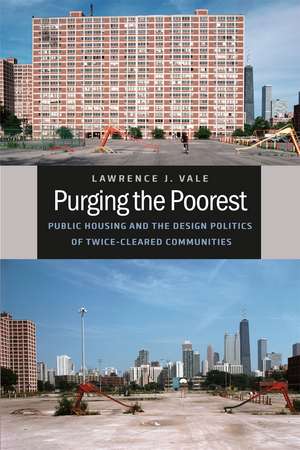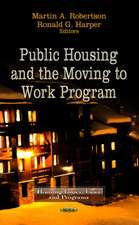Purging the Poorest: Public Housing and the Design Politics of Twice-Cleared Communities: Historical Studies of Urban America
Autor Lawrence J. Valeen Limba Engleză Paperback – 15 apr 2013
The building and management of public housing is often seen as a signal failure of American public policy, but this is a vastly oversimplified view. In Purging the Poorest, Lawrence J. Vale offers a new narrative of the seventy-five-year struggle to house the “deserving poor.”
In the 1930s, two iconic American cities, Atlanta and Chicago, demolished their slums and established some of this country’s first public housing. Six decades later, these same cities also led the way in clearing public housing itself. Vale’s groundbreaking history of these “twice-cleared” communities provides unprecedented detail about the development, decline, and redevelopment of two of America’s most famous housing projects: Chicago’s Cabrini-Green and Atlanta’s Techwood /Clark Howell Homes. Vale offers the novel concept of design politics to show how issues of architecture and urbanism are intimately bound up in thinking about policy. Drawing from extensive archival research and in-depth interviews, Vale recalibrates the larger cultural role of public housing, revalues the contributions of public housing residents, and reconsiders the role of design and designers.
Din seria Historical Studies of Urban America
-
 Preț: 224.94 lei
Preț: 224.94 lei -
 Preț: 214.33 lei
Preț: 214.33 lei -
 Preț: 153.89 lei
Preț: 153.89 lei -
 Preț: 203.46 lei
Preț: 203.46 lei -
 Preț: 132.84 lei
Preț: 132.84 lei -
 Preț: 201.36 lei
Preț: 201.36 lei -
 Preț: 196.41 lei
Preț: 196.41 lei -
 Preț: 200.74 lei
Preț: 200.74 lei -
 Preț: 178.45 lei
Preț: 178.45 lei -
 Preț: 185.70 lei
Preț: 185.70 lei -
 Preț: 215.23 lei
Preț: 215.23 lei -
 Preț: 185.94 lei
Preț: 185.94 lei -
 Preț: 205.71 lei
Preț: 205.71 lei -
 Preț: 348.08 lei
Preț: 348.08 lei -
 Preț: 283.69 lei
Preț: 283.69 lei -
 Preț: 245.49 lei
Preț: 245.49 lei -
 Preț: 264.85 lei
Preț: 264.85 lei -
 Preț: 233.25 lei
Preț: 233.25 lei -
 Preț: 218.74 lei
Preț: 218.74 lei -
 Preț: 325.05 lei
Preț: 325.05 lei -
 Preț: 249.51 lei
Preț: 249.51 lei -
 Preț: 246.09 lei
Preț: 246.09 lei -
 Preț: 277.90 lei
Preț: 277.90 lei -
 Preț: 273.67 lei
Preț: 273.67 lei -
 Preț: 290.90 lei
Preț: 290.90 lei -
 Preț: 192.30 lei
Preț: 192.30 lei -
 Preț: 261.59 lei
Preț: 261.59 lei -
 Preț: 310.30 lei
Preț: 310.30 lei -
 Preț: 227.36 lei
Preț: 227.36 lei -
 Preț: 283.30 lei
Preț: 283.30 lei -
 Preț: 246.86 lei
Preț: 246.86 lei -
 Preț: 260.82 lei
Preț: 260.82 lei -
 Preț: 275.92 lei
Preț: 275.92 lei -
 Preț: 241.19 lei
Preț: 241.19 lei -
 Preț: 273.80 lei
Preț: 273.80 lei -
 Preț: 271.67 lei
Preț: 271.67 lei -
 Preț: 247.40 lei
Preț: 247.40 lei -
 Preț: 351.69 lei
Preț: 351.69 lei -
 Preț: 267.82 lei
Preț: 267.82 lei -
 Preț: 287.33 lei
Preț: 287.33 lei -
 Preț: 232.27 lei
Preț: 232.27 lei
Preț: 262.41 lei
Nou
Puncte Express: 394
Preț estimativ în valută:
50.22€ • 52.24$ • 41.46£
50.22€ • 52.24$ • 41.46£
Carte tipărită la comandă
Livrare economică 12-26 aprilie
Preluare comenzi: 021 569.72.76
Specificații
ISBN-13: 9780226012452
ISBN-10: 022601245X
Pagini: 448
Ilustrații: 63 halftones, 6 line drawings
Dimensiuni: 152 x 229 x 26 mm
Greutate: 0.57 kg
Editura: University of Chicago Press
Colecția University of Chicago Press
Seria Historical Studies of Urban America
ISBN-10: 022601245X
Pagini: 448
Ilustrații: 63 halftones, 6 line drawings
Dimensiuni: 152 x 229 x 26 mm
Greutate: 0.57 kg
Editura: University of Chicago Press
Colecția University of Chicago Press
Seria Historical Studies of Urban America
Notă biografică
Lawrence J. Vale is the Ford Professor of Urban Design and Planning at MIT. His many books include three prize-winning volumes: Architecture, Power, and National Identity; From the Puritans to the Projects: Public Housing and Public Neighbors;and Reclaiming Public Housing: A Half Century of Struggle in Three Public Neighborhoods.
Cuprins
List of Illustrations
Preface
Acknowledgments
1. Public Housing, Design Politics, and Twice-Cleared Communities
2. Public Housing and Private Initiative: Developing Atlanta’s Techwood and Clark Howell Homes
3. Redeveloping Techwood and Clark Howell: The Purges of Progress
4. Up from Little Hell: Developing Chicago’s Frances Cabrini Homes
5. Urban Renewal and the Rise of Cabrini-Green
6. Staving Off Collapse: Mediated Violence and the Beginning of Cabrini’s End
7. Bringing the Gold Coast to the Slum: Cabrini-Green’s Redevelopment and the Litigation of Inclusion
8. Conclusion: Public Housing and the Margins of Empathy
Notes
Credits
Index
Preface
Acknowledgments
1. Public Housing, Design Politics, and Twice-Cleared Communities
2. Public Housing and Private Initiative: Developing Atlanta’s Techwood and Clark Howell Homes
3. Redeveloping Techwood and Clark Howell: The Purges of Progress
4. Up from Little Hell: Developing Chicago’s Frances Cabrini Homes
5. Urban Renewal and the Rise of Cabrini-Green
6. Staving Off Collapse: Mediated Violence and the Beginning of Cabrini’s End
7. Bringing the Gold Coast to the Slum: Cabrini-Green’s Redevelopment and the Litigation of Inclusion
8. Conclusion: Public Housing and the Margins of Empathy
Notes
Credits
Index
Recenzii
"The beauty of Mr. Vale's book is that as a scrupulous scholar he lays out his two case studies with all the careful detail you as a reader need to judge his conclusions."
"Producing a thoroughly researched, well-written volume, Vale has contributed an eloquent history to the literature on US public housing."
“Purging the Poorest advances a fresh and convincing periodization of the history of American public housing that illuminates clear patterns in the program’s convoluted past. Lawrence J. Vale’s treatment of this subject is the most original and significant I have read.”
“This is an exceptional work of original scholarship that will appeal to a wide range of historians, sociologists, political scientists, city planners, and affordable housing advocates. Its topic—public housing and its redevelopment in the past and present—examines one of the most contentious urban policies to emerge from the New Deal. Striking, thoughtful, and convincing, Vale’s account makes for engaging reading that is constantly relevant to current debates.”
“A well-written, thought-provoking book. It adds an important historical and contextual analysis to the literature on public housing.”
“Through meticulous archival research and in-depth interviewing Vale examines the nexus between architectural design and the politics which undergirded the initial development of public housing, its subsequent deterioration, destruction and finally reinvention. . . . This is a great book and one that I wish the designers and advocates for mixed income public housing transformation policies would read.”
















